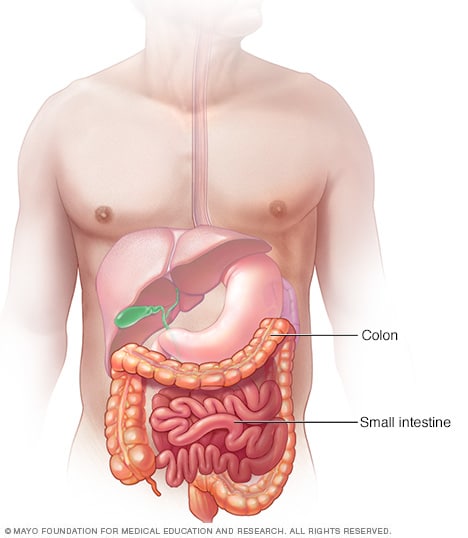Intro
Intestinal obstruction is a blockage that keeps food or liquid from passing through your small intestine or large intestine (colon). Causes of intestinal obstruction may include fibrous bands of tissue (adhesions) in the abdomen that form after surgery; hernias; colon cancer; certain medications; or strictures from an inflamed intestine caused by certain conditions, such as Crohn's disease or diverticulitis.
Without treatment, the blocked parts of the intestine can die, leading to serious problems. However, with prompt medical care, intestinal obstruction often can be successfully treated.
Symptoms
Signs and symptoms of intestinal obstruction include:
- Crampy abdominal pain that comes and goes
- Loss of appetite
- Constipation
- Vomiting
- Inability to have a bowel movement or pass gas
- Swelling of the abdomen
When to see a doctor
Diagnosis of Intestinal Obstruction
- A doctor's examination of the abdomen
- X-rays
- Computed tomography (CT)
A doctor examines the abdomen for tenderness, swelling, or masses. When an obstruction occurs, the abdomen is almost always swollen. The sounds normally made by a functioning intestine (bowel sounds), which can be heard through a stethoscope, may be much louder and higher pitched, or they may be absent. The abdomen is usually not very tender when the doctor presses on it unless rupture has caused peritonitis.
Doctors usually also do imaging studies of the abdomen, such as x-rays or a CT scan.
X-rays may show dilated loops of intestine that indicate the location of the obstruction. The x-rays also may show air around the intestine or under the layer of muscle that separates the abdomen and the chest (diaphragm). Air normally is not found in those places and thus is a sign of rupture or dead bowel.
CT of the abdomen is often used to get a better picture of the intestines and to identify the precise location and cause of the obstruction along the intestines.
Causes
The most common causes of intestinal obstruction in adults are:
- Intestinal adhesions — bands of fibrous tissue in the abdominal cavity that can form after abdominal or pelvic surgery
- Hernias — portions of intestine that protrude into another part of your body
- Colon cancer
In children, the most common cause of intestinal obstruction is telescoping of the intestine (intussusception).
Other possible causes of intestinal obstruction include:
- Inflammatory bowel diseases, such as Crohn's disease
- Diverticulitis — a condition in which small, bulging pouches (diverticula) in the digestive tract become inflamed or infected
- Twisting of the colon (volvulus)
- Impacted feces
Pseudo-obstruction
Intestinal pseudo-obstruction (paralytic ileus) can cause signs and symptoms of intestinal obstruction, but it doesn't involve a physical blockage. In paralytic ileus, muscle or nerve problems disrupt the normal coordinated muscle contractions of the intestines, slowing or stopping the movement of food and fluid through the digestive system.
Paralytic ileus can affect any part of the intestine. Causes can include:
- Abdominal or pelvic surgery
- Infection
- Certain medications that affect muscles and nerves, including antidepressants and opioids
- Muscle and nerve disorders, such as Parkinson's disease
Risk factors
Diseases and conditions that can increase your risk of intestinal obstruction include:
- Abdominal or pelvic surgery, which often causes adhesions — a common intestinal obstruction
- Crohn's disease, which can cause the intestine's walls to thicken, narrowing the passageway
- Cancer in your abdomen
Complications
Untreated, intestinal obstruction can cause serious, life-threatening complications, including:
- Tissue death. Intestinal obstruction can cut off the blood supply to part of your intestine. Lack of blood causes the intestinal wall to die. Tissue death can result in a tear (perforation) in the intestinal wall, which can lead to infection.
- Infection. Peritonitis is the medical term for infection in the abdominal cavity. It's a life-threatening condition that requires immediate medical and often surgical attention.
Treatment of Intestinal Obstruction
Suction via nasogastric tube
Fluids given by vein
Surgery for strangulation
Sometimes a colostomy
Anyone suspected of having an intestinal obstruction is hospitalized. Usually, a long, thin tube is passed through the nose and placed in the stomach (called a nasogastric tube) or into the intestine.
Suction is applied to the tube to remove the material that has accumulated above the blockage. Fluid and electrolytes (sodium, chloride, and potassium) are given by vein (intravenously) to replace water and salts lost from vomiting or diarrhea.
Sometimes an obstruction resolves without further treatment, especially if caused by scarring or adhesions. Occasionally, an endoscope (a flexible viewing tube), which is inserted through the anus, or a barium enema, which inflates the large intestine, may be used to treat some disorders, such as a twisted intestinal segment in the lower part of the large intestine.
Most often, however, surgery is done as soon as possible if doctors are concerned about strangulation.
The cause of the obstruction and the appearance of the intestine determine whether the surgeon can relieve the blockage without removing a segment of the intestine.
Sometimes adhesions can be cut to release the trapped segment of intestine, but they may re-form and obstruction may reoccur. In some cases, an ileostomy (a procedure where a cut-off end of the small intestine is permanently attached to a surgical opening in the abdominal wall) or colostomy (a surgically created opening between the large intestine and the abdominal wall.

